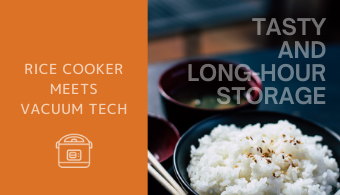Rice cooker Meets Vacuum
Built-in small diaphragm pump for tasty and long-hour storage
New flow for raice cookers
The world's first new Vacuum pressure IH heat insulation
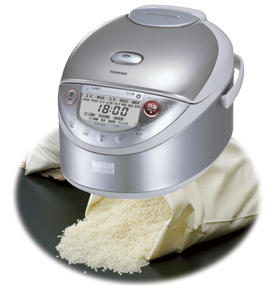
This product makes the most delicious rice ever!!
The product is the first IH rice cooker with vacuum technology in the world. This rice cooker makes the most delicious rice by making rice absorb water using a vacuum in a short time, and then by cooking the rice with pressure.
Toshiba Consumer Marketing Corporation launched "Vacuum pressure IH rice cooker and warmer" in August 2007.
The vacuum pressure cooking equipped with "Vacuum Alpha Engine II" makes delicious rice not only when freshly cooked, but also when cooled and kept warm for a long time.
Rice cooking is the cooking process of adding water to rice with a water content of around 15% and heating it to cook rice with a water content of about 63%. If the rice does not absorb enough water in the first process, the heat does not reach the inside of the rice, and the rice is cooked hard with core inside.
Posted September 2007
Interviewee: TOSHIBA CONSUMER MARKETING CORPORATION
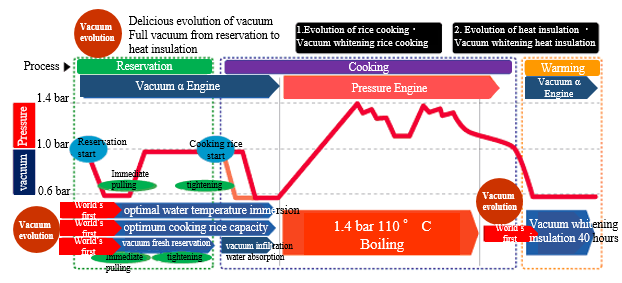 When rice is kept warm, the surface of the rice gets dry or turns yellow over time, causing a distinctive heat retention odor. In order to keep rice delicious, it is necessary to prevent water evaporation and to prevent yellowing and oxidation of the rice.
When rice is kept warm, the surface of the rice gets dry or turns yellow over time, causing a distinctive heat retention odor. In order to keep rice delicious, it is necessary to prevent water evaporation and to prevent yellowing and oxidation of the rice.
Vacuum solved the problem.
1. Newly equipped「Vacuum Alpha Engine II」
Equipped with "Vacuum Alpha Engine II" using a vacuum pump with improved durability by the adoption of a neodymium magnet.
The control accuracy between 1 atm and negative pressure of 0.6 atm is also improved.
The product realizes the ideal water content without being affected by the difference in the rice cooking capacity, or by the tap water temperature, for example, the temperature of tap water differs by 16 ° C between summer and winter in Tokyo.
2. First "Vacuum fresh reservation" in the industry to adjust excessive moisture. The rice is cooked with firmness and shine
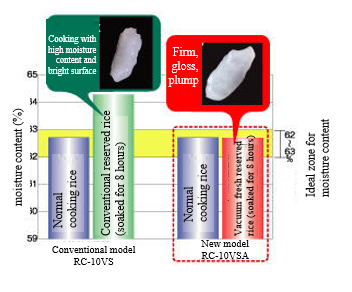
Figure. Comparison of the water content of the rice cooked by the vacuum fresh reservation
When rice is soaked in water for a long time, the water content of rice becomes less than 30% and water content on the surface of rice becomes too much, so the cooked rice becomes soggy.
Vacuum Alpha Engine II lowers the pressure of the inner pot to 0.6 atm after pressing the reservation button, allowing water permeate the rice instantly.
After the water permeates the rice, the pressure of the inner pot returns to atmospheric pressure.
The pressure of the inner pot is reduced to 0.6 atm again in the rice cooking process. It tightens the soggy rice, so it prevents the rice from falling into pieces.
3. First rice cooker in the industry to keep rice warm up to 40 hours
The pressure environment inside the inner pot is stabilized with the improvement of pressure reduction control the accuracy when rice is kept warm.
As a result, the concentration of the oxidation decreases, and it suppresses the oxidation of rice, yellowing, and unpleasant oxidized odor.
By improving the sealing degree of the lid, the amount of water evaporation is reduced to 1/4 of the evaporation of atmospheric pressure. It also prevents the rice from drying. The rice is still "kept white" even after being kept warm for 40 hours.
4. First rice cooker in the industry to keep rice warm up to 40 hours
Forged diamond silver pot.
Three-year warranty for fluorine-coated inner lid.
Improved insulation performance with VIP(Vacuum Inslation Panel) insulation structure.
Automatic cooking course.
Large display panel.
Easy Technical Explanation
Oxidation Prevention
It is necessary to block oxygen from anything that you don't want to oxidize to prevent oxidation. When a sealed space is evacuated using a vacuum pump, oxygen in the area is removed by pumping it to the outside.
In a vacuum state, the amount of oxygen decreases, so it is possible to suppress changes of substances caused by oxidation.
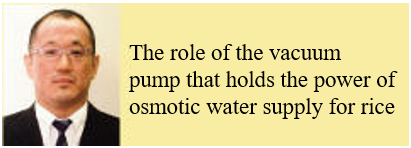 TOSHIBA CONSUMER MARKETING CORPORATION
TOSHIBA CONSUMER MARKETING CORPORATION
Consumer Electronics Department, Microwave Cooking Equipment Division, Product Planning
Manager Mr. Hiroshi Kitayama
Toshiba is the first company in the world to incorporate a vacuum pump into an IH rice cooker. It was challenging to achieve heat resistance and water resistance. The size of the pump is about a size of C battery, and it is a three-piston type diaphragm pump.
In general, the life span of a rice cooker is at least 7 to 8 years when used hard, so it was necessary for the pump to be able to operate reliably for at least the same years.
The vacuum pump is built in the back side of the lid that covers the top of the pot. Along with the vacuum pump, solenoid valves and pressure control valves also play a critical role and built in the top lid. When pumping, the solenoid valve is open, and the vacuum pump evacuates the air in the pot. When pressuring, the solenoid valve is closed, and the pressure regulator closes the pressure control valve.
This pressure control valve controls the maximum pressure and is located in the center of the inner lid. This valve consists of an austenitic stainless steel ball.
First rice cooker with Five engines in the world.
(1)Permeation and water absorption using vacuum (0.6 atm)
(2)Rice cooking using pressure (1.4 atm)
(3)Warmer that keeps rice white using a vacuum (0.6 atm)
(4)Inner pot (Forged diamond silver pot)
(5)Energy saving (Vacuum engine)
We explained to our customers that these five engines brings out the flavor (Umami) of rice and have gained their understanding. While other top-end models sold 20,000 units in the first year, we expect to sell about 60,000 units and 80,000 new models. I think the application of vacuum is the factor of this difference.
Posted September 2007
Interviewee: TOSHIBA CONSUMER MARKETING CORPORATION
Rice cooker Meets Vacuum
Solution
- Big Science
- Lifestyle
- Technology
- Medical Field
